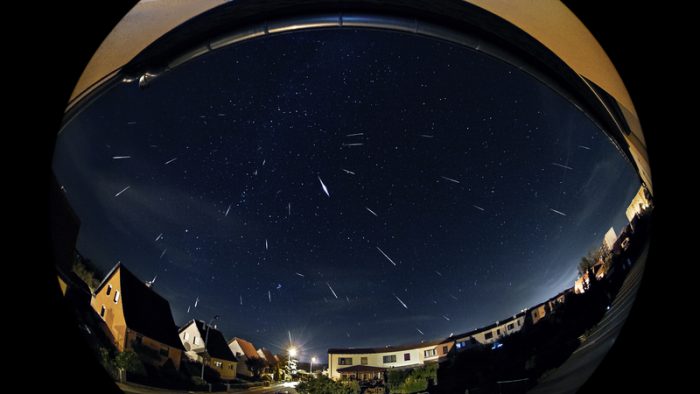Meteor showers are one of nature's greatest spectacles. They happen when small pieces of cosmic debris burn up as they fall through the Earth's atmosphere.
Every year, one of the biggest — and most regular — meteor showers is the Perseids. And it happens mid-August, a.k.a. right now, when the Earth regularly travels through the debris field of ice and dust left over by the Comet Swift-Tuttle. (This fact alone is pretty incredible since this comet orbits past Earth only once every 133 years!)
The resulting meteor shower lasts days and is somehow both subtle and mind-blowing — like an unseen hand dusting sparks across the night sky.
Awesome! Except...
Late night viewing
City lights and a bright moon (which we have now) can make viewing meteors difficult. (Getty Embed)
Even if you know when and where to look, catching meteors in action is a combination of patience, location, and wakefulness that isn't easy to come by. (Especially when you have a bedtime!) What do we mean?
The Perseids don't arrive on demand. These are random occurrences and even during the August 11 to 13 peak of dozens an hour, that can still mean long stretches of nothing at all.
Meteor viewing is also best somewhere between 2AM and right before dawn, and far away from sources of light like street lights and office towers.
Which brings us to the biggest challenge of Perseids 2019: the Moon. The fact that we got a very bright moon happening right now means that the moonlight masks the fainter meteors. Sadly, Twitter and Facebook are full of stories of people struggling a bit to see this year's display.
So whether you've tried to watch and missed out, or just felt too tired to try, we've put together a little Perseids sampler pack for your pleasure. You're welcome!
A taste of the Perseids
Here's an amazing long exposure photograph taken in Belarus of the shower. A long exposure means that the camera lens is open an extremely long time as the camera is held perfectly still. This creates a layered image of many moments in one picture!
Spectacular long exposure photo of the #PerseidsMeteorShower #Perseids2019 pic.twitter.com/vsEd1G8Kqv
— ?? Katharine Parker?? ?? (@EuropeanPenguin) August 13, 2019
This is a time lapse (sped up) video of the 2018 Perseids taken by a pilot flying during the shower.
And finally, here is a brand new collection of 40 meteors falling in real time, edited together to cut out all of those empty moments in between.
If all of this has inspired you to have a look for yourself, the Perseids will still be visible for a while now. Maybe if you're out late or up early, take a step outside and see if you get lucky? OR, just make some solid plans for August 2020. The moon should be more cooperative then!
 A long exposure image of last year's Perseids in action over Saxony, England. (© Maikthomas - Dreamstime.com)
A long exposure image of last year's Perseids in action over Saxony, England. (© Maikthomas - Dreamstime.com)









